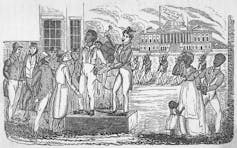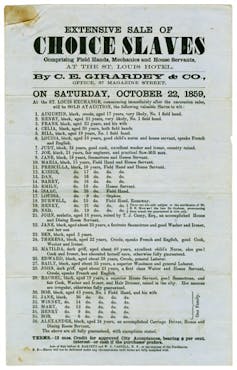How Often to Americans Read Their Bible
This article was published in 2017
People think they know everything about slavery in the United States, merely they don't. They think the bulk of African slaves came to the American colonies, but they didn't. They talk almost 400 years of slavery, but it wasn't. They merits all Southerners endemic slaves, but they didn't. Some debate it was all a long time agone, just it wasn't.
Slavery has been in the news a lot lately. From the discovery of the auction of 272 enslaved people that enabled Georgetown University to remain in operation to the McGraw-Colina textbook controversy over calling slaves "workers from Africa" and the slavery memorial being built at the University of Virginia, Americans are having conversations almost this hard period in American history. Some of these dialogues have been wrought with controversy and conflict, like the Academy of Tennessee student who challenged her professor's agreement of enslaved families.
As a scholar of slavery at the University of Texas at Austin, I welcome the public debates and connections the American people are making with history. Yet, there are still many misconceptions about slavery, as evidenced by the disharmonize at the Academy of Tennessee.
I've spent my career dispelling myths near "the peculiar institution." The goal in my courses is not to victimize i group and celebrate another. Instead, nosotros trace the history of slavery in all its forms to make sense of the origins of wealth inequality and the roots of discrimination today. The history of slavery provides vital context to contemporary conversations and counters the distorted facts, net hoaxes and poor scholarship I caution my students confronting.
Four myths virtually slavery
Myth One: The bulk of African captives came to what became the U.s.a..
Truth: Only a little more 300,000 captives, or 4-half-dozen percent, came to the United States. The majority of enslaved Africans went to Brazil, followed by the Caribbean. A significant number of enslaved Africans arrived in the American colonies by fashion of the Caribbean, where they were "seasoned" and mentored into slave life. They spent months or years recovering from the harsh realities of the Middle Passage. Once they were forcibly accepted to slave labor, many were then brought to plantations on American soil.
Myth Two: Slavery lasted for 400 years.
Pop culture is rich with references to 400 years of oppression. There seems to be defoliation between the Transatlantic Slave Trade (1440-1888) and the establishment of slavery, confusion just reinforced by the Bible, Genesis fifteen:13:
Then the Lord said to him, 'Know for certain that for four hundred years your descendants will exist strangers in a land not their own and that they will be enslaved and mistreated there.'
Mind to Lupe Fiasco – only i hip-hop creative person to refer to the 400 years – in his 2011 imagining of America without slavery, "All Blackness Everything":
[Hook] You would never know If you lot could ever be If you never try You would never meet Stayed in Africa We ain't never leave And then there were no slaves in our history Were no slave ships, were no misery, call me crazy, or isn't he See I roughshod comatose and I had a dream, it was all black everything [Verse one] Uh, and we ain't get exploited White human ain't feared then he did not destroy information technology Nosotros ain't work for gratuitous, see they had to employ it Congenital it up together so nosotros equally appointed Outset 400 years, see we really enjoyed it 
Truth: Slavery was not unique to the Usa; it is a part of nearly every nation's history, from Greek and Roman civilizations to contemporary forms of human trafficking. The American part of the story lasted fewer than 400 years.
How, and so, do nosotros calculate the timeline of slavery in America? Near historians utilize 1619 every bit a starting point: 20 Africans referred to every bit "servants" arrived in Jamestown, Virginia on a Dutch ship. Information technology's important to annotation, however, that they were not the showtime Africans on American soil. Africans first arrived in America in the tardily 16th century non as slaves but every bit explorers together with Castilian and Portuguese explorers.
[Insight, in your inbox each day. You can go it with The Conversation'south email newsletter.]
1 of the all-time-known of these African "conquistadors" was Estevancio, who traveled throughout the Southeast from present-day Florida to Texas. Equally far as the institution of chattel slavery – the handling of slaves as holding – in the United States, if we utilise 1619 as the beginning and the 1865 13th Amendment as its terminate, then information technology lasted 246 years, not 400.
Myth Iii: All Southerners owned slaves.
Truth: Roughly 25 pct of all Southerners owned slaves. The fact that one-quarter of the southern population were slaveholders is nonetheless shocking to many. This truth brings historical insight to modern conversations about inequality and reparations.
Take the case of Texas.
When it established statehood, the Lone Star State had a shorter period of Anglo-American chattel slavery than other southern states – only 1845 to 1865 – because Spain and Mexico had occupied the region for well-nigh half of the 19th century with policies that either abolished or express slavery. Notwithstanding, the number of people impacted past wealth and income inequality is staggering. Past 1860, the Texas enslaved population was 182,566, but slaveholders represented 27 percent of the population, and controlled 68 percent of the government positions and 73 percent of the wealth. These are astonishing figures, but today's income gap in Texas is arguably more stark, with 10 pct of tax filers taking habitation 50 percent of the income.
Myth Four: Slavery was a long time ago.
Truth: African-Americans have been free in this land for less fourth dimension than they were enslaved. Do the math: Blacks have been gratis for 152 years, which means that most Americans are only two to three generations away from slavery. This is not that long agone.
Over this aforementioned period, however, onetime slaveholding families accept built their legacies on the institution and generated wealth that African-Americans take non had admission to considering enslaved labor was forced. Segregation maintained wealth disparities, and overt and covert discrimination express African-American recovery efforts.
The value of slaves
Economists and historians have examined detailed aspects of the enslaved experience for as long as slavery existed. My own piece of work enters this conversation past looking at the value of individual slaves and the ways enslaved people responded to being treated as a article.
They were bought and sold only like we sell cars and cattle today. They were gifted, deeded and mortgaged the same way we sell houses today. They were itemized and insured the aforementioned way nosotros manage our assets and protect our valuables.

Enslaved people were valued at every stage of their lives, from before birth until after decease. Slaveholders examined women for their fertility and projected the value of their "future increase." As the slaves grew up, enslavers assessed their value through a rating organization that quantified their work. An "A1 Prime hand" represented 1 term used for a "first-rate" slave who could do the nigh work in a given day. Their values decreased on a quarter scale from three-fourths hands to ane-quaternary hands, to a charge per unit of zero, which was typically reserved for elderly or differently abled bondpeople (another term for slaves).
For example, Guy and Andrew, two prime males sold at the largest sale in U.Due south. history in 1859, commanded dissimilar prices. Although similar in "all marketable points in size, age, and skill," Guy was United states of america$1,280 while Andrew sold for $one,040 because "he had lost his right eye." A reporter from the New York Tribune noted "that the marketplace value of the right eye in the Southern country is $240." Enslaved bodies were reduced to monetary values assessed from yr to year and sometimes from month to calendar month for their entire lifespan and beyond. By today's standards, Andrew and Guy would be worth well-nigh $33,000-$40,000.
Slavery was an extremely diverse economic institution, one that extracted unpaid labor out of people in a variety of settings – from small unmarried-ingather farms and plantations to urban universities. This diversity was also reflected in their prices. And enslaved people understood they were treated as commodities.
"I was sold away from mammy at 3 years old," recalled Harriett Colina of Georgia. "I remembers it! It lack selling a calf from the cow," she shared in a 1930s interview with the Works Progress Assistants. "We are human beings," she told her interviewer. Those in bondage understood their status. Fifty-fifty though Harriet Colina was also picayune to recall her price when she was iii, she recalled being sold for $1,400 at age ix or 10: "I never could forget it."
Slavery in popular culture
Slavery is part and parcel of American popular civilisation, merely for 40 years the goggle box miniseries Roots was the master visual representation of the establishment, except for a handful of independent (and not widely known) films such as Haile Gerima's "Sankofa" or the Brazilian "Quilombo."
Today, from grassroots initiatives such equally the interactive Slave Habitation Projection, where schoolhouse-aged children spend the night in slave cabins, to comic skits on Saturday Night Alive, slavery is front and heart. In 2016 A&Eastward and History released the reimagined miniseries "Roots: The Saga of an American Family unit," which reflected 4 decades of new scholarship. Steve McQueen's "12 Years a Slave" was a box function success in 2013, actress Azia Mira Dungey made headlines with the popular web series called "Ask a Slave," and "The Underground" – a serial about delinquent slaves and abolitionists – was a hit for its network WGN America. With less than one year of operation, the Smithsonian's National Museum of African American History, which devotes several galleries to the history of slavery, has had more than one meg visitors.
The elephant that sits at the center of our history is coming into focus. American slavery happened – we are even so living with its consequences. I believe we are finally prepare to face up information technology, learn most it and acknowledge its significance to American history.
[You're also decorated to read everything. We get it. That's why we've got a weekly newsletter. Sign upwardly for good Sunday reading.]
Editor'due south annotation: This is an updated version of an commodity that originally appeared on Oct. 21, 2014.
Source: https://theconversation.com/american-slavery-separating-fact-from-myth-79620
0 Response to "How Often to Americans Read Their Bible"
Post a Comment